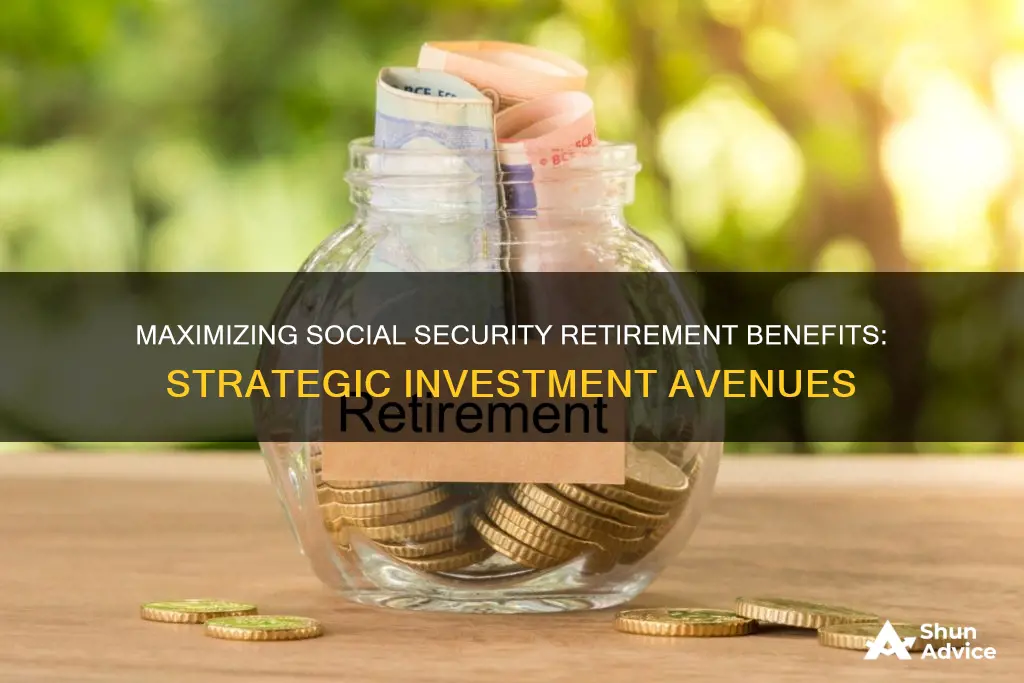
Social Security retirement benefits are a monthly check that replaces part of your income when you reduce your working hours or stop working altogether. While it's best to identify other ways to pay for monthly expenses as you age, there are ways to invest your social security benefits. However, investing social security benefits early is generally not worth the risk. If you don't need the benefits right away, experts suggest delaying until you're 70 to claim them, as the payment grows by 8% each year until then.
| Characteristics | Values |
|---|---|
| When to claim Social Security benefits | Experts urge delaying claiming Social Security benefits until 70 if the money is not needed right away. This is because the payment grows by 8% a year until age 70. |
| Taxation | Social Security benefits are taxed differently to traditional investment vehicles such as an IRA or 401(k). Most recipients are taxed on only 50-85% of their benefit, whereas 100% of the withdrawal from a traditional investment vehicle is taxed. |
| Inheritance | Social Security benefits cannot be passed to heirs other than a spouse. |
| Risk | Social Security benefits are a low-risk investment. Stocks are considered riskier for retired investors. |
| Inflation | If Social Security benefits are invested, there is a risk of damage from inflation. |
| Longevity | Generally, recipients who live past their late 70s collect more by delaying the start of their Social Security benefits. |
| Other options | If recipients don't need the benefit, they could use it to help their adult children or fund charitable causes. |
What You'll Learn

Investing early vs delaying benefits
When it comes to investing and Social Security retirement benefits, there are a few key considerations to keep in mind. Firstly, it's important to understand the impact of timing on your benefits and investments. Social Security benefits grow according to the beneficiary's years of work, income, and age. While you can start receiving monthly payments as early as 62, experts generally recommend delaying receiving benefits until later if you don't need the money right away. This is because the payment amount increases by about 8% each year until the beneficiary turns 70. For example, an individual who could receive $2,000 per month at the "full retirement age" of 66 would get $1,500 at 62 but could get $2,640 at 70.
Delaying benefits can result in a higher monthly income over time, especially if the beneficiary lives past their late 70s. However, there are also potential advantages to investing early. One advantage is compound interest, which is when interest is earned on interest over time. The earlier you start investing, the more wealth compound interest can generate in the future. For example, consider two individuals who both invest $5,000 annually with an 8% annual rate of return. The individual who starts investing at 25 and stops at 35 will have a portfolio value of just over $615,000 at age 60, while the person who starts at 35 and invests until 60 will have a portfolio value of just over $430,000.
Additionally, starting to invest early gives you more time to take advantage of market gains and ride out any downturns. Younger investors also tend to have a higher risk tolerance, allowing them to invest in riskier assets like stocks, which have the potential for higher returns over time. However, investing early also comes with challenges, such as having less access to investment capital and potentially needing to invest a larger portion of your income to meet your retirement goals.
Ultimately, the decision to invest early or delay benefits depends on various factors, including your financial situation, risk tolerance, and long-term goals. Consulting with a financial advisor can help you navigate these considerations and determine the best approach for your specific circumstances.
Young Investors: Emulate Warren Buffett's Strategy
You may want to see also

How to spend benefits
While Social Security benefits are meant to replace part of your income when you stop working, they may not cover all your expenses. Here are some ways you can spend your Social Security retirement benefits:
Delay Claiming Benefits
If you don't need the money right away, experts suggest delaying claiming your Social Security benefits until you're 70. This way, your payment grows by 8% each year until you reach 70. For example, if you're eligible for a monthly benefit of $2,000 at the age of 66, you would get $1,500 at 62 but could get $2,640 at 70. While delaying means forgoing payments for a few years, the higher payment later on can offset the initial loss. Generally, the longer you live, the more you benefit by waiting, as the bigger income will make up for the money lost earlier.
Spend on Yourself and Your Family
You can use your Social Security benefits to fund your daily expenses and improve your quality of life. If you have adult children, you could help them with daycare costs, a down payment on a home, or other significant expenses. You could also donate to charitable causes that are important to you.
Pay Premiums of Life Insurance Policies
If you want to leave a more substantial inheritance for your heirs, you can use your benefits to pay premiums for life insurance policies. This way, your heirs will receive a tax-free death benefit. However, be cautious, as committing your benefits to insurance premiums carries the risk of the policy lapsing if the money is needed for living expenses instead.
Invest in Stocks, Bonds, or Insurance Products
While investing your Social Security benefits may be an option, financial experts generally advise against it. The benefit already provides a guaranteed 8% annual growth, which is challenging to find in other investments. Stocks are risky, and it's hard for bonds to keep up with inflation. Additionally, investing your benefits exposes a stable income stream to the volatility of the market.
Pay Taxes
If you're receiving Social Security benefits, you may be taxed on only 50% to 85% of your benefit. In comparison, withdrawals from traditional investment vehicles like an IRA or 401(k) are taxed at 100%. Therefore, from a tax perspective, it may be better to spend your Social Security benefits and minimize withdrawals from these other accounts.
Remember, the choices outlined above may depend on your specific goals and circumstances. It's always a good idea to consult with a financial advisor to determine the best approach for your situation.
Understanding the Investment Policy Statement: A Guide to Retirement Planning
You may want to see also

Tax implications
Social Security retirement benefits are subject to federal income tax, although a portion of the benefits are exempt from taxes. The percentage of your Social Security retirement benefit that is taxable depends on your total income, not your age. People with lower total retirement incomes get larger exemptions. The IRS uses a tiered system based on "combined income" to determine the percentage of your Social Security that is taxable. Combined income includes adjusted gross income, any non-taxable interest, and half of your Social Security benefits.
If your combined income is under $25,000 as a single filer or $32,000 as a joint filer, your Social Security benefits are not taxed. For combined incomes between $25,000 and $34,000 for single filers or $32,000 and $44,000 for joint filers, up to 50% of benefits can be taxed. For incomes above $34,000 for single filers or above $44,000 for joint filers, up to 85% of benefits can be taxed.
Most states do not tax Social Security benefits, but some do. For 2024, nine states tax Social Security benefits: Colorado, Connecticut, Kansas, Minnesota, Montana, New Mexico, Rhode Island, Utah, and Vermont. However, some states have higher income thresholds for taxing benefits or offer higher deductions and exemptions to reduce the tax burden.
Supplemental Security Income (SSI) is not taxed. SSI is a monthly Social Security benefit for people with limited resources, low incomes, and who are blind, disabled, or 65 or older.
If you are concerned about owing taxes on your Social Security benefits, you can choose to have federal taxes withheld from your monthly Social Security payments. The withholding options are 7%, 10%, 12%, or 22% of your benefits. Alternatively, you can make quarterly estimated tax payments.
Omaxe Chandni Chowk: Worth the Investment?
You may want to see also

Impact of stock market performance
The stock market's performance can have both direct and indirect impacts on an individual's Social Security retirement benefits.
Firstly, it is important to note that the Social Security Trust Fund does not invest any of its funds in the stock market. Therefore, stock price fluctuations do not directly impact benefits. However, there are certain scenarios where the stock market's performance can affect benefits.
One scenario is if an individual starts receiving Social Security benefits before reaching full retirement age and exercises non-qualified employee stock options. In this case, profits from the sale of these options are considered earned income. If the total work income, including profits from the stock options, exceeds the legal limit, Social Security benefits will be reduced by $1 for every $2 over the limit.
Another scenario is when an individual's total reportable income, including income from various sources such as interest payments, dividends, and capital gains, exceeds a certain threshold. In this case, a portion of their Social Security benefits may become taxable, effectively reducing the net benefit received.
Additionally, the stock market's performance can impact an individual's decision-making regarding retirement intentions and Social Security benefit claims. For example, a strong stock market performance may lead to higher incomes and increased retirement assets, potentially delaying retirement intentions. On the other hand, a stock market decline may cause individuals to reevaluate their retirement plans and consider claiming Social Security benefits earlier.
It is worth noting that the stock market's performance is just one factor among many that influence retirement intentions and benefit claims. Other factors, such as personal health, family history, and overall economic conditions, also play a significant role in these decisions.
Furthermore, the stock market's performance can impact the broader context of Social Security funding and policy discussions. For instance, the well-known funding challenges faced by the Social Security Trust Fund have led to proposals for alternative investment strategies, including investing in the stock market or allowing individuals to invest their Social Security funds in equities markets. While some argue that investing in the stock market could take advantage of higher rates of return, others caution that it introduces an element of risk, especially in the event of a market collapse or prolonged bear market.
In conclusion, while the stock market's performance does not directly impact Social Security retirement benefits, it can have indirect effects through its influence on individual financial situations and broader policy considerations.
Coinbase: Where to Invest Today
You may want to see also

Private market interference
There are concerns about the US government investing Social Security funds in the stock market, namely, that it could interfere with private markets. Critics worry that such a large influx of capital into the market could upset the balance and lead to government interference in the private sector.
In 1935, Congress ruled out investing Social Security reserves in private stocks and bonds due to fears that politicians would use investment policy to interfere with markets or meddle in private businesses. There were also concerns about the fund's managers having to sell assets at a loss, which would be a target for public criticism, and that liquidating large amounts of securities could destabilize markets, depressing the value of assets held in private portfolios.
However, since 1935, market conditions have changed. Stock and bond markets are now far larger, less volatile, and more efficient, so the argument goes that trust fund investment activities are less likely to disrupt markets. Furthermore, the trust fund is unlikely to be forced to sell assets at a loss because the fund has significant and growing reserves, and trustees would sell government securities to cover any short-run gaps.
Despite this, the pressures placed on lawmakers by special interests and the stress of re-election are argued to be greater now than in the past, so the fear of political interference remains. Chairman Greenspan of the Federal Reserve Board stated that he did not "believe that it is politically feasible to insulate such huge funds from government direction".
To address these concerns, it has been proposed that an independent agency, the Social Security Reserve Board (SSRB), be created to manage the trust fund's investments. This board would be appointed by the president and confirmed by the Senate, with members serving staggered terms of at least ten years. The SSRB would select several private sector fund managers through competitive bids to invest portions of the fund's reserves. These fund managers would only be authorized to make passive investments in securities of companies chosen to represent broad market indexes. Social Security's investments would be pooled with the funds of private account holders, making it more difficult for politicians to interfere.
Unlocking Clean Geothermal Energy Potential
You may want to see also
Frequently asked questions
It is a monthly check that replaces part of your income when you reduce your hours or stop working altogether.
The amount you receive is based on how long you worked and how much you earned during your working lifetime.
You can start receiving benefits as early as age 62, but experts recommend delaying as long as possible if the money is not needed right away, as the payment grows by 8% each year until age 70.
Yes, by taking benefits early, you are betting that you will die before the "break-even age", which is about 78. If you live past this age and have claimed early, you may end up with less total income from Social Security.
While it is possible to invest your benefits, it is generally not recommended. The guaranteed 8% annual growth of Social Security benefits is difficult to match with other investments, and delaying benefits will likely provide a greater financial benefit over time.







